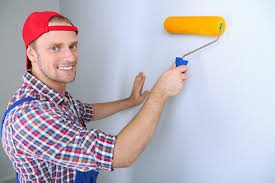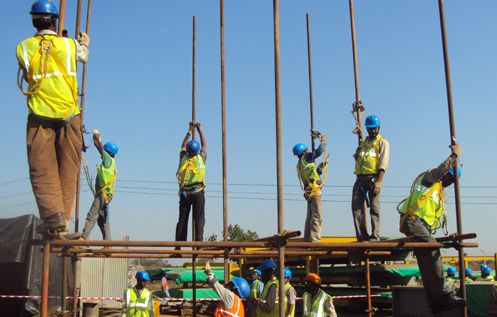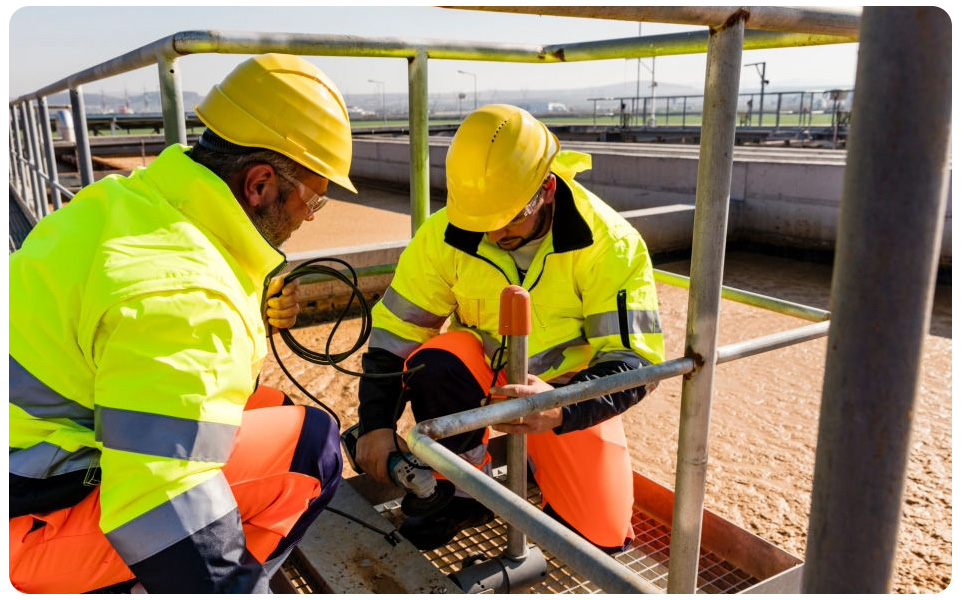Chargehand – Painting and Decorating (6 month course)
Chargehand – Painting and Decorating click here
Brief Job Description: The job role is responsible for executing complex decorative paint
finishes on surfaces using faux painting using general and spray paint techniques within
specified time and tolerance. The individual should possess good factual knowledge, and
shall be able to maintain safe and quality work practices.

Personal Attributes: This job role requires the individual to be physically and mentally fit
to carry out painting work at a construction site. The individual should be organized,
diligent, methodical, demonstrative and able to implement and maintain safety practices.
The individual should have independent ability to take quick decisions and should be well
versed in painting works. The individual should possess good organizational, interpersonal
and communication skills along with factual knowledge of painting works and shall also be
responsible for own work and learning.
Description
Sector Sector is conglomeration of different business operations having similar
business and interests. It may also be defined as a distinct subset of the
economy whose components share similar characteristics and interests.
Sub-Sector Sub-Sector is derived from a further breakdown based on the characteristics
and interests of its components
Occupation Occupation is a set of job roles, which perform similar/related set of
functions in an industry
Job role Job role defines a unique set of functions that together form a unique
employment opportunity in an organization.
Occupational Standards
(OS)
OS specify the standards of performance an individual must achieve when
carrying out a function in the workplace, together with the knowledge and
understanding they need to meet the standard consistently. Occupational
Standards are applicable both in the Indian contexts.
Performance Criteria Performance Criteria are statements that together specify the standard of
performance required when carrying out a task.
Qualifications Pack (QP) Qualifications Pack comprises the set of OS, together with the educational,
training and other criteria required to perform a job role. A Qualification Pack
is assigned a unique qualification pack code
Qualification Pack Code Qualification Pack Code is a unique reference code that identifies a
qualifications pack.
National Occupational
Standards (NOS) NOS are Occupational Standards which apply uniquely in the Indian context.
Scope Scope is the set of statements specifying the range of variables that an
individual may have to deal with in carrying out the function which have a
critical impact on the quality of performance required.
Knowledge and
Understanding
Knowledge and Understanding are statements which together specify the
technical, generic, professional and organizational specific knowledge that an
individual needs in order to perform to the required standard
Organizational Context Organizational Context includes the way the organization is structured and
how it operates, including the extent of operative knowledge managers have
of their relevant areas of responsibility.
Technical Knowledge Technical Knowledge is the specific knowledge needed to accomplish specific
designated responsibilities.
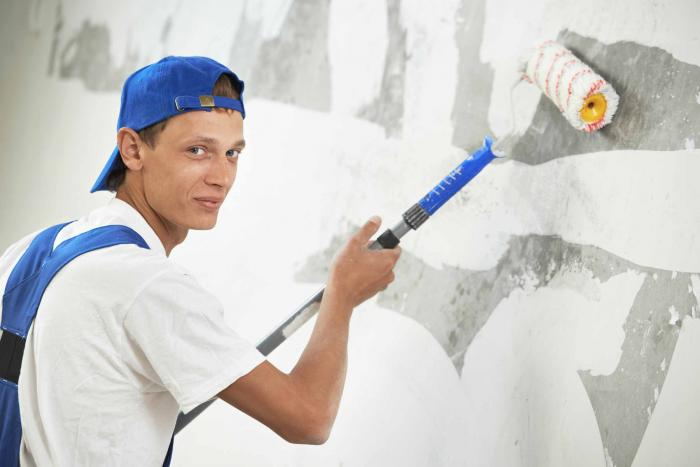
Core Skills / Generic Skills Core Skills or Generic Skills are a group of skills that are key to learning and
working in today’s world. These skills are typically needed in any work
environment. In the context of the OS, these include communication related
skills that are applicable to most job roles.
Keywords /Terms Description
CON Construction
NSQF National Skill Qualifications Framework
QP Qualification Pack
OS Occupational Standards
Carry out spray painting on all types of surfaces as per requirement
Description This unit describes the skills and knowledge required to carry out spray painting on
all types of surfaces as per requirement
Scope The scope covers the following:
Carry out preparation of tools, equipment’s & materials required for spray
painting
Carry out spray painting on surfaces and products
Performance Criteria (PC) w.r.t. the Scope
Element Performance Criteria
Carry out preparation of tools, equipment’s & materials required for spray painting
To be competent, the user / individual on the job must be able to:
PC1. set up machine to paint with different paints and other solutions such as
silver and copper solution, rubber, paint, glaze, oil, or rust proofing materials
PC2. select and fix correct fluid tip, air cap, hoses, filters and tips, in preparation
for spray painting works
PC3. weigh or measure chemicals, coatings, or paints before loading to machines
PC4. attach and align machine parts such as rollers, guides, brushes, and blades,
using hand tools, if required

PC5. attach hoses or nozzles to machines, using wrenches and pliers, and make
adjustments to obtain the proper dispersion of spray as per required
thickness of paint film
Carry out spray painting on surfaces and products
PC6. fill hoppers, reservoirs, troughs, or pans with material used to paint or coat
surfaces as per applicability
PC7. operate the spray paint machine at appropriate temperature, air pressure
and circulation to ensure proper flow or spray of coatings or paints
PC8. apply paint by spray machine on various surfaces using appropriate
overlapping technique to achieve required level finish and texture as per
specification
PC9. hold the spray gun at appropriate distance from surface and operate
appropriately as per requirement/instructions
PC10. maintain proper coverage at corners and edges
PC11. perform touch-up painting, using paint brushes as per requirement
PC12. clean nozzles, containers and hoses of machines after usage

Knowledge and Understanding (K)
A. Organizational Context (Knowledge of the company /organization and its processes)
The user/individual on the job needs to know and understand:
KA1. standard procedure for painting works
KA2. safety rules and regulations to handle required painting tools,
tackles and equipment required to perform the painting work
KA3. personal protection including the use of the related safety gears, safety
equipment & safety drills that may be required
KA4. service request procedures for tools, materials and equipments,
B. Technical Knowledge
The user/individual on the job needs to know and understand:
KB1. basic sketches / schematic working drawing relevant to painting work
KB2. basic principles of measurement, geometry and arithmetic calculations
KB3. units of measurements and conversion of units
KB4. how to prepare any specific surface before application of spray paints
KB5. set up and operate of spray machine along with appropriate safety
measures
KB6. how to select and fix correct fluid tip, air cap, hoses, filters and tips on the
spray painting machine
KB7. how to set up spray paint machine with appropriate paint / coat material
like silver, copper etc.
KB8. how to attach and align machine parts such as rollers, guides, brushes,
blades,
hoppers, reservoirs, troughs, or pans dials, handwheels, valves, or switches, etc.
KB9. how to operate spray paint machine, as per correct methodology
KB10.how to maintain uniformity in overlap and finish
Skills (S)
A. Core Skills/
Generic Skills
Writing Skills
The user/ individual on the job needs to know and understand how to:
SA1. write in one or more language, preferably in the local language of the site
Reading Skills
The user/ individual on the job needs to know and understand how to:
SA2. read in one or more language, preferably in the local language of the site
SA3. read sketches or instructions provided for the work
SA4. read instructions, guidelines, sign boards, safety rules and safety tags at the
construction site
SA5. read instructions related to exit routes during emergencies at the work place
Oral Communication (Listening and Speaking skills)
The user/ individual on the job needs to know and understand how to:
SA6. speak in one or more language, preferably in one of the local language of
the site
SA7. listen and follow instructions given by the superior
SA8. orally communicate with co-workers regarding support required to
complete the respective work
B. Professional
Skills
Decision Making
The user/individual on the job needs to know and understand how to:
SB1. decide whether his workplace is safe for working and also relevant work is
not creating hazardous conditions for others
SB2. decide on appropriate temperature, air pressure and circulation while
operating machine
Plan and Organize
The user/individual on the job needs to know and understand how to:
SB3. plan work and organize required resource in coordination with team
members and superiors
Customer centricity
The user/individual on the job needs to know and understand how to:
SB4. complete work as per agreed time and quality
Problem solving
The user/individual on the job needs to know and understand how to:
SB5. resolve any conflict within the team
SB6. rectify the paint job by performing necessary touch ups using paint brush, as
per requirements
Analytical Thinking
The user/ individual on the job needs to know and understand how to:
SB7. determine quantity of material required for painting works
SB8. analyze correct temperature, air pressure and circulation to ensure proper
flow or spray of coatings or paints
SB9. optimize resources
SB10. minimize wastages
SB11. revert to superior for selection/sorting of materials
Critical Thinking
The user/individual on the job needs to know and understand how to:
SB12. evaluate the complexity of the tasks to determine if any guidance is required
from the superior
SB13. identify and assess how violation of safety norms may lead to accidents
Create ornamental designs on finished masonry, surfaces using texture paints and stencil painting technique
Description This unit describes the skills and knowledge required to create ornamental designs
on finished masonry, surfaces using texture paints and stencil painting technique
Scope The scope covers the following:

Ensure preparation of base surfaces prior to painting and upkeep and
maintenance of tools
Carry out preparation of paint mix using various constituents as per
specification
Produce ornamental designs on surfaces using texture paints and stencil
painting technique
Performance Criteria (PC) w.r.t. the Scope
Element Performance Criteria
Ensure preparation of base surfaces prior to painting and upkeep and maintenance of tools
To be competent, the user / individual on the job must be able to:
PC1. carry out visual and physical check for suitability of surface, prior to painting
PC2. measure the surface to be painted and calculate the appropriate quantity of
required materials as per applicability
PC3. ensure surface is free from dust, dirt and grease and is prepared
appropriately prior to application of paints
PC4. apply putty to fill gaps and depressions on the surface to be painted for
preparation of a leveled surface if required
PC5. ensure that adjacent surfaces are covered with drop cloths/ masking
tape/paper and all removable items/fixtures are removed prior to painting
PC6. ensure proper cleaning ,maintenance and upkeep of painting tools and
equipment’s before and after use
Carry out preparation of paint mix using various constituents as per specification
PC7. select appropriate painting material and mixing ingredients as per
requirement /specified finish
PC8. identify base colour as per the requirements/instructions
PC9. select appropriate colorants suitable for colour match, to meet aesthetic
requirements
PC10. mix specified amount of paint material with additives as per specified ratio
PC11. follow standard procedure for effective mixing and dilution of paints
PC12. add reducer/thinner/ water to adjust viscosity of paint mix as per
requirement
Produce ornamental designs on surfaces using texture paints and stencil painting technique
PC13. apply primer coats of paint to the finished/leveled surfaces as per
specifications
PC14. apply main coat of texture paint over primer coat within specified time limit as per specification
PC15. apply smooth or sand texture paint over the prepared surface after
application of primer coat using paint brush, roller or spray as per
applicability
PC16. apply a fresh coat of latex based paint to the required surface for stencil
painting technique
PC17. position the stencil on the wall, using a level to ensure appropriate pattern
PC18. hold the stencil in place on the surface using two to three small pieces of
masking tape and remove the tape post usage
PC19. apply paint over the stencil using paint brush to obtain desired finish
Knowledge and Understanding (K)
A. Organizational Context (Knowledge of the company /organization and its processes)
The user/individual on the job needs to know and understand:
KA1. standard procedure for painting works
KA2. safety rules and regulations to handle required painting tools,
tackles and equipment required to perform the painting work
KA3. personal protection including the use of the related safety gears, safety
equipment & safety drills that may be required
KA4. service request procedures for tools, materials and equipment’s,
B. Technical Knowledge
The user/individual on the job needs to know and understand:
KB1. basic sketches / schematic working drawing relevant to painting work
KB2. basic principles of measurement, geometry and arithmetic calculations
KB3. units of measurements and conversion of units
KB4. how to select & use different painting tools (such as brushes, rollers ,
painting bucket, stirrers, scrapers ,sand papers, putty blades, etc.) and appropriate
paint materials and mixing ingredients (such as scrape, primer, base color,
tint base, colorants, varnishes, enamel, etc.)
KB5. standard size of all painting tools, materials and components
KB6. methods of protecting adjacent surfaces prior to painting
KB7. how to mix the correct amount of paint material as per specified ratio
KB8. adhesives used for binding coats of paint such as oil, turpentine, mildew
remover

KB9. painting related ingredients such as paint, stain, lacquer, shellac, or varnish,
etc.
KB10.how to remove accessories prior to finishing, and mask areas that should not
be exposed to finishing processes or substances
KB11.how to apply primer, sand paper, and main coatings of finishing materials
KB12.methods and techniques of producing ornamental designs on surfaces
KB13. various types of stencils used for surfaces
KB14. various types of texture paints used
Skills (S)
A. Core Skills/
Generic Skills
Writing Skills
The user/ individual on the job needs to know and understand how to:
SA1. write in one or more language, preferably in the local language of the site
Reading Skills
The user/ individual on the job needs to know and understand how to:
SA2. read in one or more language, preferably in the local language of the site
SA3. read sketches or instructions provided for the work
SA4. read instructions, guidelines, sign boards, safety rules and safety tags at the
construction site
SA5. read instructions related to exit routes during emergencies at the work place
Oral Communication (Listening and Speaking skills)
The user/ individual on the job needs to know and understand how to:
SA6. speak in one or more language, preferably in one of the local language of
the site
SA7. listen and follow instructions given by the superior
SA8. orally communicate with co-workers regarding support required to
complete the respective work
B. Professional
Skills
Decision Making
The user/individual on the job needs to know and understand how to:
SB1. decide whether his workplace is safe for working and also relevant work is
not creating hazardous conditions for others
SB2. decide on appropriate painting material and mixing ingredients as per requirements
SB3. decide on appropriate colorants for color match
Plan and Organize
The user/individual on the job needs to know and understand how to:
SB4. plan work and organize required resource in coordination with team
members and superiors
Customer centricity
The user/individual on the job needs to know and understand how to:
SB5. complete work as per agreed time and quality
Problem solving
The user/individual on the job needs to know and understand how to:
SB6. resolve any conflict within the team
Analytical Thinking
The user/ individual on the job needs to know and understand how to:
SB7. determine quantity of material required for painting works
SB8. optimize resources
SB9. minimize wastages
SB10. revert to superior for selection/sorting of materials
Critical Thinking
The user/individual on the job needs to know and understand how to:
SB11. evaluate the complexity of the tasks to determine if any guidance is required
from the superior
SB12. identify and assess how violation of safety norms may lead to accidents
Carry out preparatory works prior to painting and decorating on finished masonry
surface
Description This unit describes the skills and knowledge required to carry out preparatory works
prior to painting and decorating on finished masonry surface
Scope The scope covers the following:
Read and interpret painting elevation drawings, manuals, plans and
specifications for painting and decorating works
Carry out preparatory works prior to painting on finished masonry surface
Performance Criteria (PC) w.r.t. the Scope
Element Performance Criteria
Read and interpret painting elevation drawings, manuals, plans and specifications for painting and decorating works
To be competent, the user/individual on the job must be able to:
PC1. identify, read, assess, and interpret painting elevation drawings, manuals,
plans and specifications for painting works
PC2. identify symbols and abbreviations relating to painting and decorating
projects on plans /drawings as per requirements
PC3. identify location, dimensions and requirements for any additional works as
per specifications
PC4. interpret job specifications from drawings, notes and descriptions as per
requirements
PC5. interpret standards of work and finishes from the project specifications as
per worksite requirements
PC6. interpret material attributes from specifications as per requirement
PC7. verify amendments to plans and drawings, if any, for painting and
decorating works with the superiors
PC8. measure area to be painted and estimate material required for painting as
per applicability
Carry out preparatory works prior to painting on finished masonry surface
PC9. perform visual checks to ensure safe condition of access and sufficient work
space for painting works
PC10. supervise the erection and dismantle of temporary scaffold and work
platforms prior to commencement of painting work
PC11. select appropriate coatings, paints and other finishing ingredients as per
specification/desired finish
PC12. ensure base surface is prepared as per specification
PC13. identify base colour and colorants as per applicability
PC14. check paint to be applied for workability and consistency
PC15. adjust the viscosity of paint as per requirement
PC16. prepare and mix paints and varnishes as per requirement
PC17. carry out work in compliance with safety guidelines
Knowledge and Understanding (K)
A. Organizational Context (Knowledge of the company / organization and its processes)
The user/individual on the job needs to know and understand:
KA1. standard procedures for painting work
KA2. safety rules and regulations for handling and storing relevant tools and
equipment and materials for painting works
KA3. personal protection including the use of the related safety gears and
equipment
KA4. precautions and measures required in the lifting and movement of
heavy components and materials
KA5. service request procedures for tools, materials and equipment’s
KA6. statutory compliance requirements related to working at height
B. Technical Knowledge
The user/individual on the job needs to know and understand:
KB1. basic sketches / schematic working drawing relevant to painting works
KB2. basic principles of measurement, geometry and arithmetic calculation
KB3. linear conversion of units
KB4. units of measurements
KB5. how to select & use different painting tools (such as brushes, rollers ,
painting bucket, stirrers, scrapers ,sand papers, putty blades, etc.) and appropriate
materials and mixing ingredients (such as scrape, primer, base colour, tint
base, colorants, varnishes, enamel, etc.)
KB6. standard size of all painting tools, materials and components
KB7. methods of protecting adjacent surfaces prior to painting
KB8. how to mix the correct amount of paint material as per specified ratio
KB9. how to adjust viscosity of paint mix as per requirement
KB10.different reducers/thinners used for adjusting viscosity
KB11.application of primer as per requirement
KB12.adhesives used for binding coats of paint such as oil, turpentine, mildew
remover, or other preparations, and sand rough spots

KB13.appropriate methods for surface preparation, prior to application of paint
KB14.application of primer, sand paper, and main coatings of finishing materials
KB15.methods and techniques of producing decorative paint finishes including
sponging, dragging, grabbing, marbling, etc.
Skills (S)
Writing Skills
A. Core Skills/
Generic Skills
The user/ individual on the job needs to know and understand how to:
SA1. write in one or more language, preferably in the local language of the site
and basic English
SA2. provide clear and simple instructions, details & sketches to sub-ordinate
Reading Skills
The user/ individual on the job needs to know and understand how to:
SA3. read one or more language, preferably in the local language of the site and
basic English
SA4. read sketches, drawing or instructions provided for the scaffolding work
SA5. read various, sign boards, safety rules and safety tags , instructions related
to exit routes during emergency at the workplace
Oral Communication (Listening and Speaking skills)
The user/ individual on the job needs to know and understand how to:
SA6. speak one or more language, preferably in the local language of the site
SA7. orally and effectively communicate with co-workers
B. Professional Skills
Decision Making
The user/individual on the job needs to know and understand how to:
SB1. decide whether the work place is safe for working and also relevant task is
not creating hazardous condition for others
SB2. decide on manpower, tools , material and equipment for relevant work
SB3. decide on appropriate coating, paints and other finishing materials to attain
the required finish
SB4. decide on appropriate base color and colorants as per applicability
Plan and Organize
The user/individual on the job needs to know and understand how to:
SB5. plan work & organize required resource in coordination with team members
and superior
Customer centricity
The user/individual on the job needs to know and understand how to:
SB6. perform work as per agreed time schedule and quality
Problem solving
The user/individual on the job needs to know and understand how to:
SB7. resolve concerns raised by the painting gang
SB8. resolve any conflict within the team
Analytical Thinking
The user/individual on the job needs to know and understand how to:
SB9. correlate the sequence of painting works with respect to other
proceeding activity of other trade
SB10. optimize resources
SB11. minimize wastages
Critical Thinking
The user/individual on the job needs to know and understand how to:
SB12. evaluate the complexity of the task and seek assistance and support
wherever required
SB13. identify violation of any safety norms which may lead to accidents
Carry out preparatory works prior to painting and decorating on finished masonry
surface
Carry out decorative paint finishes using faux painting
Description This unit describes the skills and knowledge required to carry out decorative paint
finishes using faux painting
Scope The scope covers the following:
Produce decorative paint finish through use of marbling technique
Produce decorative paint finish through use of ragging technique
Produce decorative paint finish through use of sponging technique
Produce decorative paint finish through use of stippling technique
Produce decorative paint finish through use of sheen stripping technique
Produce decorative paint finish through use of dragging technique
Performance Criteria (PC) w.r.t. the Scope
Element Performance Criteria
Produce decorative paint finish through use of marbling technique
To be competent, the user/individual on the job must be able to:
PC1. apply specified coats of white basecoat and allow each to dry thoroughly
PC2. mix raw sienna color with white spirit and oil glaze
PC3. mix the sienna color with acrylic latex glaze in case of use of latex paints
PC4. apply with an artist brush on required surface to give the required finish
PC5. wipe away varying amounts of wet glaze, allowing patches of light and dark
to form using a cloth by parchment technique
PC6. apply the sienna glaze in lines, varying the thickness to create the “veins” of
marble by using a thin artist brush
PC7. repeat the technique of veining and parchment over entire area to produce
desired effect
Produce decorative
paint finish through
use of ragging
technique
PC8. apply appropriate coats of white basecoat and allow each to dry thoroughly
PC9. mix raw sienna color with white spirit and oil glaze
PC10. mix the sienna color with acrylic latex glaze in case of use of latex paints
PC11. apply glaze mix with an artist brush/roller on required surface to give the
required finish
PC12. wipe away varying amounts of wet glaze by using a cloth maintaining the
wet edge and reshape the rag throughout the process
Produce decorative paint finish through use of sponging technique
PC13. select appropriate base coat for application of decorative paint finish
PC14. prepare the glaze coat by mixing latex paint with latex glaze mixture as per
paint mix ratio

PC15. apply paint mix on foam boards before applying on the surface
PC16. apply basecoat, first “cutting” out around ceiling, corners, baseboards and doors
PC17. prepare the 4:1 latex glaze/deep tone paint mixture and pour into a roller
tray lined with plastic liner
PC18. prepare a sea sponge(s) by soaking in water to soften, then squeeze out all excess water
PC19. apply a wash or glaze on top with a dampened sponge and create a mottled look
PC20. apply a uniform glaze coat over the solid base with a brush or roller
PC21. remove some of the glaze to expose the undercoat before drying out the glaze coat
Produce decorative paint finish through use of stippling technique
PC22. apply solid base coat on required surface and allow it to dry
PC23. apply a different color top coat starting from one side of the wall to the other
in wide strips from ceiling to floor as per the requirements
PC24. ensure removal of the dots of paint by stabbing through a large soft bristled brush before drying out
PC25. ensure blotting of the excess paint from the stippling brush after certain periods
Produce decorative paint finish through use of sheen stripping technique
PC26. paint the required surface with quality acrylic interior flat or eggshell paint
and allow it to dry
PC27. mark off the area to be painted with semi-gloss paint–typically in a vertical
pattern by using painter’s tape and a level
PC28. ensure that the lines are perfectly vertical using the level
PC29. paint the area to be “striped” with quality semi-gloss paint – same color as
the flat paint and allow it to dry as per the requirements
PC30. remove the painter’s tape to keep the area clean
Produce decorative paint finish through use of dragging technique
PC31. apply base coat (typically 2 layers or as per the requirements)
PC32. ensure that the top coat is diluted with one part paint to one part glaze or as
per the requirements
PC33. apply a thin layer of the colored glaze/topcoat mixture by using a dragging
brush (or long haired paint brush)
PC34. move the brush from top to bottom giving long vertical strokes and
maintaining even pressure and keeping the brush strokes as parallel as
possible
PC35. apply varnish coat after the paint coat dries
Knowledge and Understanding (K)
A. Organizational Context (Knowledge of the company / organization and its processes)
The user/individual on the job needs to know and understand:
KA1. standard procedures for painting work
KA2. safety rules and regulations for handling and storing relevant tools and
equipment and materials for painting works
KA3. personal protection including the use of the related safety gears and
equipment
KA4. precautions and measures required in the lifting and movement of
heavy components and materials
KA5. service request procedures for tools, materials and equipment’s
KA6. statutory compliance requirements related to working at height
B. Technical Knowledge
The user/individual on the job needs to know and understand:
KB1. basic sketches / schematic working drawing relevant to painting works
KB2. basic principles of measurement, geometry and arithmetic calculation
KB3. linear conversion of units
KB4. units of measurements
KB5. how to select & use different painting tools (such as brushes, rollers ,
painting
bucket, stirrers, scrapers ,sand papers, putty blades, etc.) and appropriate
materials and mixing ingredients (such as scrape, primer, base colour, tint
base, colorants, varnishes, enamel, etc.)
KB6. standard size of all painting tools, materials and components
KB7. methods of protecting adjacent surfaces prior to painting
KB8. how to mix the correct amount of paint material as per specified ratio
KB9. how to adjust viscosity of paint mix as per requirement
KB10.properties and application of different reducers/thinners used for adjusting
viscosity
KB11.how to apply primer as per requirement
KB12.properties and application of adhesives used for binding coats of paint such
as oil, turpentine, mildew remover, or other preparations, and sand rough spots
KB13. various methods of surface preparation, prior to application of paint
KB14.how to apply primer, sand paper, and main coatings of finishing materials
KB15.methods and techniques of producing decorative paint finishes including
sponging, dragging, grabbing, marbling, etc.
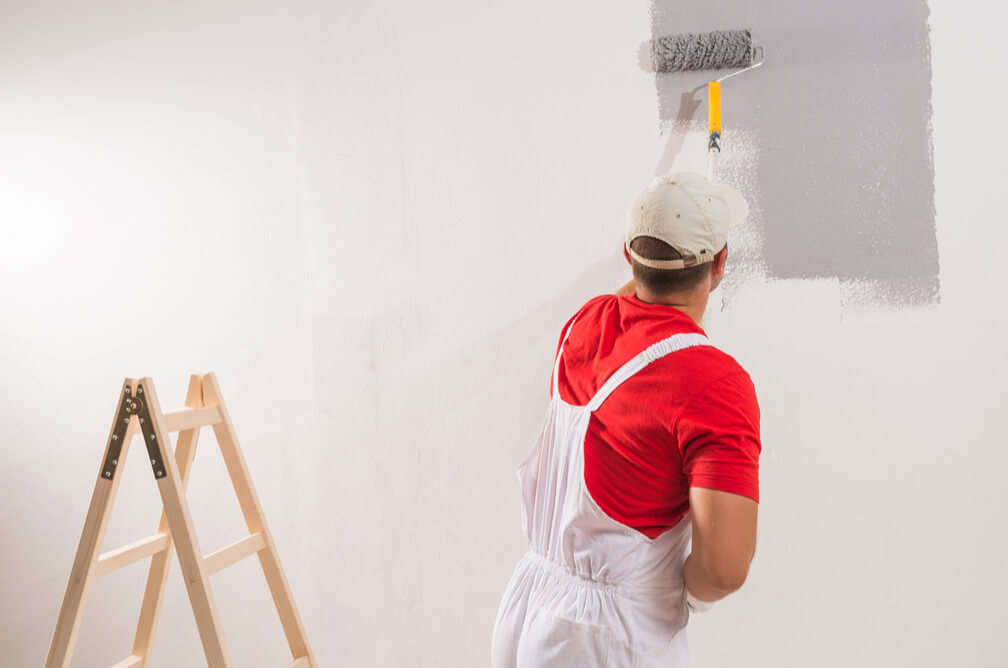
Skills (S)
A. Core Skills/ Generic Skills Writing Skills
The user/ individual on the job needs to know and understand how to:
SA1. write in one or more language, preferably in the local language of the site
and basic English SA2. provide clear and simple instructions, details & sketches to sub-ordinate
Reading Skills
The user/ individual on the job needs to know and understand how to:
SA3. read one or more language, preferably in the local language of the site and
basic English
SA4. read sketches, drawing or instructions provided for the scaffolding work
SA5. read various, sign boards, safety rules and safety tags , etc.
SA6. read instructions related to exit routes during emergency at the workplace
Oral Communication (Listening and Speaking skills)
The user/ individual on the job needs to know and understand how to:
SA7. speak one or more language, preferably in the local language of the site
SA8. orally and effectively communicate with co-workers
B. Professional
Skills
Decision Making
The user/individual on the job needs to know and understand how to:
SB1. decide whether the work place is safe for working and also relevant task is
not creating hazardous condition for others
SB2. decide on manpower, tools , material and equipment for relevant work
SB3. decide on appropriate base coat for application of paint
SB4. decide on suitability of paint mixture prepared for application
Plan and Organize
The user/individual on the job needs to know and understand how to:
SB5. plan work & organize required resource in coordination with team members
and superior
Customer centricity
The user/individual on the job needs to know and understand how to:
SB6. perform work as per agreed time schedule and quality
Problem solving
The user/individual on the job needs to know and understand how to:
SB7. resolve concerns raised by the painting gang
SB8. resolve any conflict within the team
SB9. wipe away varying amounts of wet glaze from the surface
Analytical Thinking
The user/individual on the job needs to know and understand how to:
SB10. correlate the sequence of painting works with respect to other
proceeding activity of other trade
SB11. optimize resources
SB12. minimize wastages
Critical Thinking
The user/individual on the job needs to know and understand how to:
SB13. evaluate the complexity of the task and seek assistance and support
wherever required
SB14. identify violation of any safety norms which may lead to accidents
Work effectively in a team to deliver desired results at the workplace
Description This unit describes the skills and knowledge required to work effectively within a
team to achieve the desired results.
Scope The scope covers the following:
Interact and communicate effectively with co-workers, superiors and subordinates across different teams
Support co-workers, superiors and sub-ordinates within the team and across
interfacing teams to ensure effective execution of assigned task
Performance Criteria (PC) w.r.t. the Scope
Element Performance Criteria
Interact and
communicate in
effective and
conclusive manner
To be competent, the user / individual on the job must be able to:
PC1. pass on work related information/ requirement clearly to the team
members
PC2. inform
co-workers and superiors about any kind of deviations from work
PC3. address the problems effectively and report if required to immediate
supervisor appropriately
PC4. receive instructions clearly from superiors and respond effectively on the
same
PC5. communicate to team members/subordinates for appropriate work
technique and method
PC6. seek clarification and advice as per the requirement and applicability
Support co-workers to execute project requirements
PC7. hand over the required material, tools tackles, equipment and work fronts
timely to interfacing teams
PC8. work together with co-workers in a synchronized manner
Knowledge and Understanding (K)
A. Organizational
Context
(Knowledge of
the company /
organization and
its processes)
The user/individual on the job needs to know and understand:
KA1. own roles and responsibilities
KA2. importance of effective communication and establishing strong working
relationships with co-workers
KA3. risks of a failure in teamwork in terms of effects on project outcomes,
timelines, safety at the construction site, etc.
KA4. different modes of communication, and its appropriate usage
KA5. importance of creating healthy and cooperative work environment among
the gangs of workers
B. Technical Knowledge
The user/individual on the job needs to know and understand:
KB1. different activities within his work area where an interaction with other
workers is required
KB2. applicable techniques of work, properties of materials used, tools and
tackles used, safety standards that co- workers might need as per the requirement
KB3. importance of proper and effective communication and the expected
adverse effects in case of failure relating to quality, timelines, safety, risks at the
construction project site
KB4. importance and need of supporting co-workers facing problems for smooth
functioning of work
Skills (S)
A. Core Skills/
Generic Skills
Writing Skills
The user/ individual on the job needs to know and understand how to:
SA1. write in one or more languages, preferably in the local language of the site
Reading Skills
The user/ individual on the job needs to know and understand how to:
SA2. read in one or more languages, preferably in the local language of the site
SA3. read communication from team members regarding work completed,
materials used, tools and tackles used, support required
Oral Communication (Listening and Speaking skills)
The user/ individual on the job needs to know and understand how to:
SA4. speak in one or more languages, preferably in one of the local languages of
the site
SA5. listen and follow instructions / communication shared by superiors/ co-
workers regarding team requirements or interfaces during work processes
SA6. orally communicate with co-workers regarding support required to
complete the respective work

B. Professional Skills
Decision Making
The user/individual on the job needs to know and understand how to:
SB1. decide on what information is to be shared with co-workers within the team
or from interfacing gang of workers
Plan and Organize
The user/individual on the job needs to know and understand how to:
SB2. plan work and organize required resources in coordination with team
members
Customer centricity
The user/individual on the job needs to know and understand how to:
SB3. complete all assigned task in coordination with team members
Problem solving
The user/individual on the job needs to know and understand how to:
SB4. take initiative in resolving issues among co-workers or report the same to
superiors
Analytical Thinking
The user/individual on the job needs to know and understand how to:
SB5. ensure best ways of coordination among team members
SB6. communicate with co-workers considering their educational / social
background
Critical Thinking
The user/individual on the job needs to know and understand how to:
SB7. evaluate the complexity of task and determine if any guidance is required
from superiors
Plan and organize work to meet expected outcomes
Description This unit describes the knowledge and the skills required for an individual to plan
and organize own work in order to meet expected outcome.
Scope This scope covers the following:
Prioritize work activities to achieve desired results
Organize desired resources prior to commencement of work
Performance Criteria (PC) w.r.t. the Scope
Element Performance Criteria
Prioritize work activities to achieve desired results
To be competent, the user / individual on the job must be able to:
PC1. understand clearly the targets and timelines set by superiors
PC2. plan activities as per schedule and sequence
PC3. provide guidance to the subordinates to obtain desired outcome
PC4. plan housekeeping activities prior to and post completion of work
Organize desired resources prior to commencement of work
PC5. list and arrange required resources prior to commencement of work
PC6. select and employ correct tools, tackles and equipment for completion of
desired work
PC7. complete the work with allocated resources
PC8. engage allocated manpower in an appropriate manner
PC9. use resources in an optimum manner to avoid any unnecessary wastage
PC10. employ tools, tackles and equipment with care to avoid damage to the
same
PC11. organize work output, materials used, tools and tackles deployed,
PC12. processes adopted to be in line with the specified standards and instructions
Knowledge and Understanding (K)
A. Organizational
Context
(Knowledge of
the company /
organization and
its processes)
The user/individual on the job needs to know and understand:
KA1. importance of proper housekeeping
KA2. policies, procedures and work targets set by superiors
KA3. roles and responsibilities in executing the work for subordinates and self
B. Technical
Knowledge
The user/individual on the job needs to know and understand:
KB1. standard practices of work to be adopted for assigned task
KB2. how to use available resources in a judicious and appropriate manner to
minimize wastages or damage
Skills (S)
A. Core Skills/
Generic Skills
Writing Skills
The user/ individual on the job needs to know and understand how to:
SA1. write in one or more language, preferably in the local language of the site
SA1. list out the assigned works and targets
Reading Skills
The user/ individual on the job needs to know and understand how to:
SA2. read in one or more language, preferably in the local language of the site
SA3. read communication from co-workers, superiors and notices from other
departments as per requirement of the level
Oral Communication (Listening and Speaking skills)
The user/ individual on the job needs to know and understand how to:
SA4. speak in one or more language, preferably in one of the local language of the
site
SA5. listen and follow communication shared by co-workers regarding standard
work processes, resources available, timelines, etc.
SA6. communicate effectively with co-workers and subordinates
B. Professional
Skills
Decision Making
The user/individual on the job needs to know and understand how to:
SB1. decide on what sequence is to be adopted for execution of work
Plan and Organize
The user/individual on the job needs to know and understand how to:
SB2. plan and organize the materials, tools, tackles and equipment required to
execute the work
Customer centricity
The user/individual on the job needs to know and understand how to:
SB3. complete all assigned task with proper planning and organizing
Problem solving
The user/individual on the job needs to know and understand how to:
SB4. arrange or seek help to arrange for material, tools and tackles in case of
shortfall
Analytical Thinking
The user/individual on the job needs to know and understand how to:
SB5. analyze areas of work which could result in a delay of work, wastage of
material or damage to tools and tackles
Critical Thinking
The user/individual on the job needs to know and understand how to:
SB6. evaluate potential solutions to minimize avoidable delays and wastages at
the construction site
Work according to personal health, safety and environment protocol at construction site
Description This NOS covers the skill and knowledge required for an individual to work according
to personal health, safety and environmental protocol at construction site
Scope The scope covers the following:
Follow safety norms as defined by organization
Adopt healthy & safe work practices
Implement good housekeeping and environment protection process and
activities
Performance Criteria (PC) w.r.t. the Scope
Element Performance Criteria
Follow safety norms
as defined by
organization
To be competent, the user / individual on the job must be able to:
PC1. identify and report any hazards, risks or breaches in site safety to the
appropriate authority
PC2. follow emergency and evacuation procedures in case of accidents, fires,
natural calamities
PC3. follow recommended safe practices in handling construction materials,
including chemical and hazardous material whenever applicable
PC4. participate in safety awareness programs like Tool Box Talks, safety
demonstrations, mock drills, conducted at site
PC5. identify near miss , unsafe condition and unsafe act
Adopt healthy & safe work practices Implement good housekeeping practices
PC6. use appropriate Personal Protective Equipment (PPE) as per work
requirements including:
Head Protection (Helmets)
Ear protection
Fall Protection
Foot Protection
Face and Eye Protection,
Hand and Body Protection
Respiratory Protection (if required)
PC7. handle all required tools, tackles , materials & equipment safely
PC8. follow safe disposal of waste, harmful and hazardous materials as per EHS
guidelines
PC9. install and apply properly all safety equipment as instructed
PC10. follow safety protocol and practices as laid down by site EHS department
PC11. collect and deposit construction waste into identified containers before
disposal, separate containers that may be needed for disposal of toxic or
hazardous wastes
PC12. apply ergonomic principles wherever required
Knowledge and Understanding (K)
A. Organizational
Context
(Knowledge of
the company /
organization and
its processes)
The user/individual on the job needs to know and understand:
KA1. reporting procedures in cases of breaches or hazards for site safety,
accidents, and emergency situations as per guidelines
KA2. types of safety hazards at construction sites
KA3. basic ergonomic principles as per applicability
B. Technical
Knowledge
The user/individual on the job needs to know and understand:
KB1. the procedure for responding to accidents and other emergencies at site
KB2. appropriate personal protective equipment to used based on various
working conditions
KB3. importance of handling tools, equipment and materials as per applicable
KB4. health and environments effect of construction materials as per
applicability
KB5. various environmental protection methods as per applicability
KB6. storage of waste including the following at appropriate location:
non-combustible scrap material and debris
combustible scrap material and debris
general construction waste and trash (non-toxic, non-hazardous)
any other hazardous wastes
any other flammable wastes
KB7. how to use hazardous material, in a safe and appropriate manner as per
applicability
KB8. safety relevant to tools, tackles, & requirement as per applicability
KB9. housekeeping activities relevant to task
Skills (S)
A. Core Skills/
Generic Skills
Writing Skills
The user/ individual on the job needs to know and understand how to:
SA2. write in one or more language, preferably in the local language of the site
SA3. fill safety formats for near miss, unsafe conditions and safety suggestions
Reading Skills
The user/ individual on the job needs to know and understand how to:
SA4. read in one or more language, preferably in the local language of the site
SA5. read sign boards, notice boards relevant to safety
Oral Communication (Listening and Speaking skills)
The user/ individual on the job needs to know and understand how to:
SA6. speak in one or more language, preferably in one of the local language of
the site
SA7. listen instructions / communication shared by site EHS and superiors
regarding site safety, and conducting tool box talk
SA8. communicate reporting of site conditions, hazards, accidents, etc.
B. Professional Skills
Decision Making
The user/individual on the job needs to know and understand how to:
SB1. not create unsafe conditions for others
SB2. keep the workplace clean and tidy
Plan and Organize
SB3. N.A
Customer centricity
SB4. N.A
Problem solving
The user/individual on the job needs to know and understand how to:
SB5. identify safety risks that affect the health, safety and environment for self
and others working in the vicinity, tackle it if within limit or report to appropriate
authority
Analytical Thinking
The user/individual on the job needs to know and understand how to:
SB6. assess and analyze areas which may affect health, safety and environment
protocol on the site
Critical Thinking
The user/individual on the job needs to know and understand how to:
SB7. ensure personal safety behavior
SB8. respond to emergency

